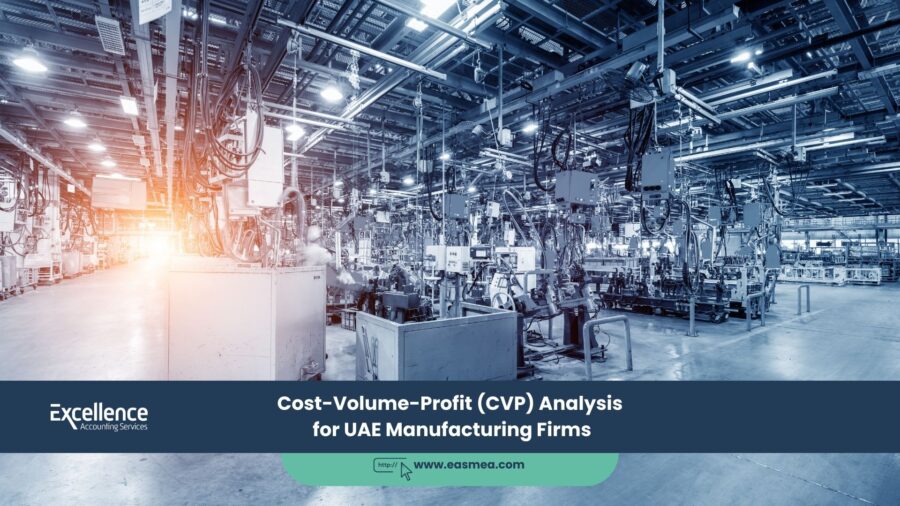A Guide to Cost-Volume-Profit (CVP) Analysis for UAE Manufacturing Firms
For any manufacturing firm in the UAE, the path to profitability is a constant balancing act. How many units do we need to sell to cover our costs? What will happen to our profit if we reduce our selling price to gain market share? How will a rise in raw material costs affect our bottom line? Answering these fundamental questions with confidence is the key to sustainable success in a competitive industrial landscape.
The most powerful tool for answering these questions is **Cost-Volume-Profit (CVP) analysis**. CVP analysis is a cornerstone of managerial accounting that examines the relationship between a company’s costs, its sales volume, and its profitability. It is not just an academic exercise; it is a practical, strategic tool that allows manufacturers to understand their cost structure, determine their break-even point, and make informed decisions about pricing, production, and strategy.
This guide will provide a clear and practical overview of CVP analysis, tailored for the specific context of manufacturing firms in the UAE. We will break down the core components, explain how to calculate your break-even point, and demonstrate how this analysis can be used to drive better business decisions.
Key Takeaways
- CVP Analysis is a Strategic Tool: It helps manufacturers understand how changes in costs and sales volume will impact their profit.
- Understanding Your Costs is the First Step: The analysis requires you to accurately classify all your costs as either **fixed** (e.g., factory rent) or **variable** (e.g., raw materials).
- The Break-Even Point is the Key Metric: CVP analysis allows you to calculate the exact number of units you need to sell to cover all your costs and reach zero profit.
- It Enables “What-If” Scenarios: The model can be used to instantly see the profit impact of decisions like changing a selling price, launching a marketing campaign, or investing in new machinery.
- Essential for Budgeting and Planning: CVP analysis is a fundamental tool for setting sales targets and preparing annual budgets. A professional CFO service can implement this for you.
The Core Components of CVP Analysis
To perform a CVP analysis, you must first understand and classify your costs. This is the foundation of the entire model.
1. Fixed Costs
These are costs that do not change in total, regardless of your production volume (within a relevant range). They are the costs of being in business.
- Examples for a UAE Manufacturer: Factory rent, administrative staff salaries, insurance, depreciation on machinery.
2. Variable Costs
These are costs that change in direct proportion to your production volume. The more you produce, the higher your total variable costs.
- Examples for a UAE Manufacturer: Raw materials, direct labor wages (for production line workers), packaging materials, sales commissions.
3. Contribution Margin
This is one of the most important concepts in CVP analysis. The contribution margin is the amount of revenue from each sale that is left over to “contribute” to covering your fixed costs and then generating a profit.
Contribution Margin per Unit = Selling Price per Unit – Variable Cost per Unit
Calculating the Break-Even Point: The Heart of CVP
The break-even point is the level of sales at which your total revenues equal your total costs. It is the point of zero profit and zero loss. Knowing this number is critical for any manufacturer.
Break-Even Point in Units
This formula tells you how many units you need to sell to cover your costs.
Break-Even Point (in Units) = Total Fixed Costs / Contribution Margin per Unit
Example Calculation:
Let’s imagine a furniture manufacturer in Jebel Ali Free Zone (Jafza).
- Total Monthly Fixed Costs (rent, salaries, etc.): AED 200,000
- Selling Price per Dining Table: AED 1,000
- Variable Cost per Dining Table (wood, labor, etc.): AED 600
Step 1: Calculate Contribution Margin per Unit
AED 1,000 (Price) – AED 600 (Variable Cost) = **AED 400**
Step 2: Calculate Break-Even Point in Units
AED 200,000 (Fixed Costs) / AED 400 (Contribution Margin) = **500 units**
Conclusion: The company must manufacture and sell 500 dining tables each month just to cover its costs. The 501st table sold will generate the first dirham of profit.
Driving Profitability with Excellence Accounting Services (EAS)
CVP analysis is a powerful tool, but its accuracy depends on the quality of your financial data. EAS provides the expertise to implement and leverage this analysis for your manufacturing firm.
- Cost Accounting and Analysis: Our team helps you accurately classify your fixed and variable costs, providing the clean data needed for a reliable CVP analysis. This is a core part of our accounting and bookkeeping services.
- Strategic CFO Services: Our outsourced CFOs use CVP analysis to provide strategic guidance on pricing, cost control, and profitability improvement. We help you run “what-if” scenarios to make data-driven decisions.
- Budgeting and Forecasting: We use CVP principles to help you develop realistic annual budgets and sales targets that are aligned with your profit goals.
- Business Consultancy: We can conduct a full CVP analysis as part of a broader project to assess the feasibility of a new product line or a change in your production process.
Frequently Asked Questions (FAQs)
Break-even analysis is a key component *of* CVP analysis. CVP is a broader concept that also looks at target profit analysis and allows you to model the impact of various changes, while break-even analysis specifically calculates the point of zero profit.
You simply add your target profit to your fixed costs in the formula:
Units to Sell = (Total Fixed Costs + Target Profit) / Contribution Margin per Unit
Using our example, to make a profit of AED 40,000, they would need to sell: (200,000 + 40,000) / 400 = 600 units.
The main limitation is that it relies on assumptions. It assumes that fixed costs are constant, variable costs per unit are constant, and the selling price is constant. In reality, these can change (e.g., you might get a volume discount on raw materials). It is a model, not a perfect prediction.
It becomes more complex. You need to calculate a “weighted average” contribution margin based on your expected sales mix of the different products. Any change in the sales mix will change the overall break-even point.
CVP analysis is typically done on a pre-tax basis to determine operating profit. However, you can adapt it for after-tax profit targets. More importantly, the cost classifications required for CVP (fixed vs. variable) are essential for good management accounting, which is a prerequisite for accurate Corporate Tax filing under the new UAE Corporate Tax regime.
The Margin of Safety is the difference between your actual or budgeted sales and your break-even sales. It tells you how much your sales can drop before you start making a loss. A higher margin of safety indicates a lower risk.
Absolutely. You can use the model to see how a price increase or decrease will affect your break-even point and your overall profitability. For example, a price cut will lower your contribution margin, meaning you will have to sell many more units to make the same profit.
A semi-variable (or mixed) cost has both a fixed and a variable component. A classic example is a utility bill, which might have a fixed monthly connection fee plus a variable charge based on consumption. For CVP analysis, these costs need to be split into their fixed and variable parts using statistical methods.
You should review your CVP analysis whenever there is a significant change in your business—such as a change in selling prices, a major increase in raw material costs, or a change in your fixed costs (like moving to a new, more expensive factory). It is also a core part of the annual budgeting process.
All the data comes from your own accounting records. This is why having an accurate and well-maintained accounting system is absolutely essential. You cannot perform a meaningful CVP analysis with inaccurate or incomplete financial data.
Conclusion: The Manufacturer’s Compass
In the capital-intensive world of manufacturing, making decisions based on gut feeling is a recipe for failure. Cost-Volume-Profit analysis provides a clear, data-driven compass to guide your strategic decisions. By understanding the intricate relationship between your costs, your production volume, and your profitability, you can set realistic targets, make smarter pricing decisions, and confidently navigate the path to sustainable growth in the UAE’s industrial sector.
Do You Know Your Break-Even Point?
Contact Excellence Accounting Services for an expert analysis of your cost structure and profitability drivers.




